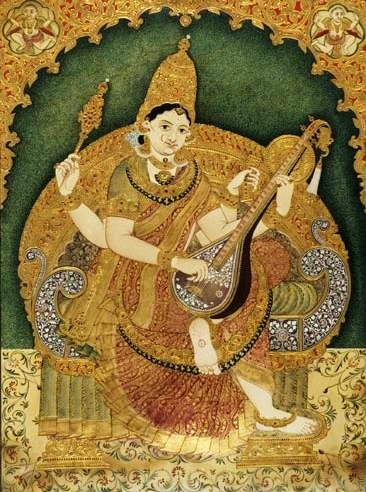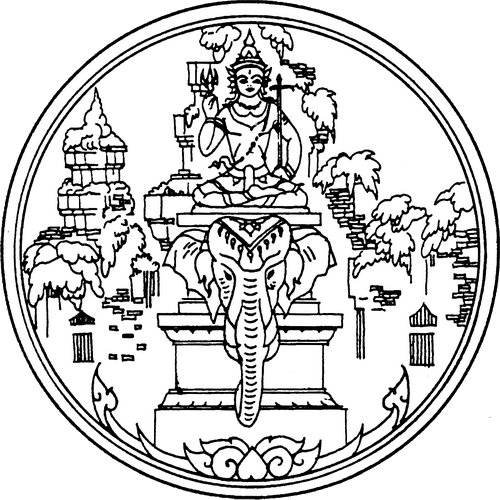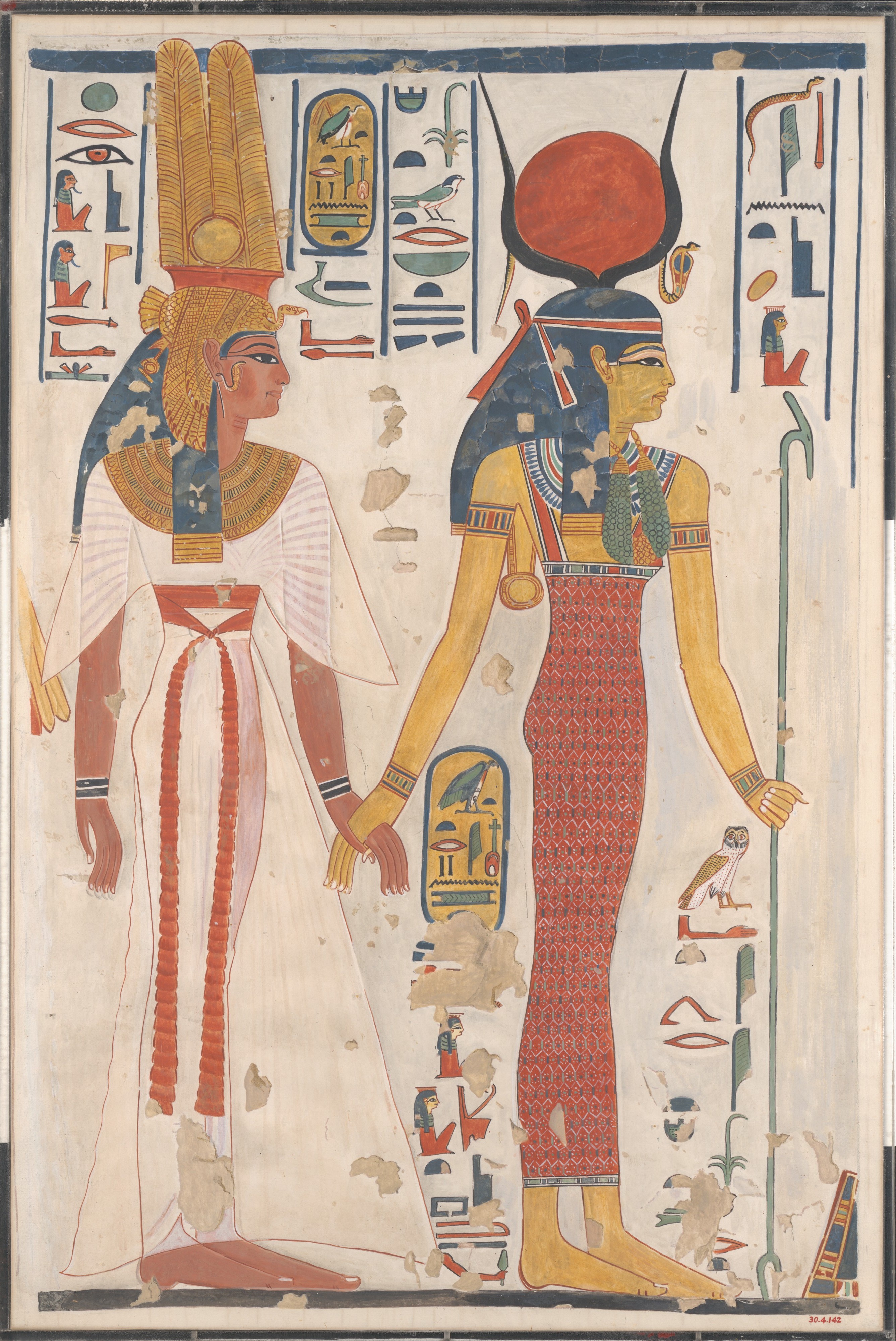|
Vāc
Vac (, ') is a Vedic goddess who is a personified form of divine speech. She enters into the inspired poets and visionaries, gives expression and energy to those she loves; she is called the "mother of the Vedas" and consort of Prajapati, the Vedic embodiment of mind. She is also associated with Indra in Aitareya Aranyaka.''The Myths and Gods of India'' Alain Daniélou, pages 260-261 Elsewhere, such as in the , she is stated to be the wife of Vision (''Kashyapa''), the mother of Emotions, and the friend of Musicians (''Gandharva''). She is identified with goddess |
Saraswati
Saraswati (, ), also spelled as Sarasvati, is one of the principal Devi, goddesses in Hinduism, revered as the goddess of knowledge, education, learning, arts, speech, poetry, music, purification, language and culture. Together with the goddesses Lakshmi and Parvati, she forms the trinity of chief goddesses, known as the Tridevi. Sarasvati is a pan-Indian deity, venerated not only in Hinduism but also in Jainism and Buddhism.Ludvik (2007), pp. 1, 11. She is one of the prominent goddesses in the Historical Vedic religion, Vedic tradition (1500 to 500 BCE) who retains her significance in later Hinduism. In the Vedas, her characteristics and attributes are closely connected with the Sarasvati River, making her one of the earliest examples of a Rivers in Hinduism, river goddess in Indian tradition. As a deity associated with a river, Sarasvati is revered for her dual abilities to purify and to nurture fertility. In later Vedic literature, particularly the Brahmanas, Sarasvati is i ... [...More Info...] [...Related Items...] OR: [Wikipedia] [Google] [Baidu] |
Hindu Deities
Hindu deities are the gods and goddesses in Hinduism. Deities in Hinduism are as diverse as its traditions, and a Hindu can choose to be polytheistic, pantheistic, monotheistic, monistic, even agnostic, atheistic, or humanist. Julius J. Lipner (2009), Hindus: Their Religious Beliefs and Practices, 2nd edition, Routledge, , p. 8; Quote: "(...) one need not be religious in the minimal sense described to be accepted as a Hindu by Hindus, or describe oneself perfectly validly as Hindu. One may be polytheistic or monotheistic, monistic or pantheistic, even an agnostic, humanist or atheist, and still be considered a Hindu." The terms and epithets for deities within the diverse traditions of Hinduism vary, and include Deva, Devi, Ishvara, Ishvari, Bhagavān and Bhagavati. The deities of Hinduism have evolved from the Vedic era (2nd millennium BCE) through the medieval era (1st millennium CE), regionally within Nepal, Pakistan, India and in Southeast Asia, and across Hinduism ... [...More Info...] [...Related Items...] OR: [Wikipedia] [Google] [Baidu] |
Hindu Goddesses
Hindu deities are the gods and goddesses in Hinduism. Deities in Hinduism are as diverse as its traditions, and a Hindu can choose to be polytheistic, pantheistic, monotheistic, monistic, even agnostic, atheistic, or humanist. Julius J. Lipner (2009), Hindus: Their Religious Beliefs and Practices, 2nd edition, Routledge, , p. 8; Quote: "(...) one need not be religious in the minimal sense described to be accepted as a Hindu by Hindus, or describe oneself perfectly validly as Hindu. One may be polytheistic or monotheistic, monistic or pantheistic, even an agnostic, humanist or atheist, and still be considered a Hindu." The terms and epithets for deities within the diverse traditions of Hinduism vary, and include Deva, Devi, Ishvara, Ishvari, Bhagavān and Bhagavati. The deities of Hinduism have evolved from the Vedic era (2nd millennium BCE) through the medieval era (1st millennium CE), regionally within Nepal, Pakistan, India and in Southeast Asia, and across Hinduism's d ... [...More Info...] [...Related Items...] OR: [Wikipedia] [Google] [Baidu] |
Vedas
FIle:Atharva-Veda samhita page 471 illustration.png, upright=1.2, The Vedas are ancient Sanskrit texts of Hinduism. Above: A page from the ''Atharvaveda''. The Vedas ( or ; ), sometimes collectively called the Veda, are a large body of religious texts originating in ancient India. Composed in Vedic Sanskrit, the texts constitute the oldest layer of Sanskrit literature and the oldest Hindu texts, scriptures of Hinduism. There are four Vedas: the Rigveda, the Yajurveda, the Samaveda and the Atharvaveda. Each Veda has four subdivisions – the Samhitas (mantras and benedictions), the Brahmanas (commentaries on and explanation of rituals, ceremonies and sacrifices – Yajñas), the Aranyakas (text on rituals, ceremonies, sacrifices and symbolic-sacrifices), and the Upanishads (texts discussing meditation, philosophy and spiritual knowledge).Gavin Flood (1996), ''An Introduction to Hinduism'', Cambridge University Press, , pp. 35–39A Bhattacharya (2006), ''Hindu Dharma: Introduc ... [...More Info...] [...Related Items...] OR: [Wikipedia] [Google] [Baidu] |
Goddess
A goddess is a female deity. In some faiths, a sacred female figure holds a central place in religious prayer and worship. For example, Shaktism (one of the three major Hinduism, Hindu sects), holds that the ultimate deity, the source of all reality, is Mahadevi (Supreme Goddess) and in some forms of Tantric Shaivism, the pair of Shiva and Shakti are the ultimate principle (with the goddess representing the active, creative power of God). Meanwhile, in Vajrayana, Vajrayana Buddhism, ultimate reality is often seen as being composed of two principles depicted as two deities in union (Yab-Yum, yab yum, "father-mother") symbolising the non-duality of the two principles of perfect wisdom (female) and skillful compassion (male). A single figure in a monotheistic faith that is female may be identified simply as god because of no need to differentiate by gender or with a diminutive. An experiment to determine the effect of psychedelics on subjects composed of leaders from diverse religio ... [...More Info...] [...Related Items...] OR: [Wikipedia] [Google] [Baidu] |
Prajapati
Prajapati (, ) is a Vedas, Vedic deity of Hinduism. He is later identified with Brahma, the creator god. Prajapati is a form of the creator-god Brahma, but the name is also the name of many different gods, in many Hindu scriptures, ranging from the creator god Brahma to being the same as one of the following deities: Vishvakarma, Agni, Indra, Daksha, and many others, because of the diverse Hindu cosmology. In classical and medieval era literature, Prajapati is the metaphysical concept called Brahman as Prajapati-Brahman, and Brahman is the primordial matter that made Prajapati. Etymology Prajapati (Sanskrit: ) is a compound of "praja" (creation, procreative powers) and "pati" (lord, master). The term means "lord of creatures", or "lord of all born beings". In the later Vedic texts, Prajapati is a distinct Vedic deity, but whose significance diminishes. Later, the term is synonymous with other gods, particularly Brahma. Still later, the term evolves to mean any divine, semi-di ... [...More Info...] [...Related Items...] OR: [Wikipedia] [Google] [Baidu] |
Rigvedic Deities
Rigvedic deities are deities mentioned in the sacred texts of Rigveda, the principal text of the historical Vedic religion of the Vedic period (1500–500 BCE). There are 1,028 hymns (sūkta) in the Rigveda. Most of these hymns are dedicated to specific deities. The most prominent deity is Indra, the sky god and also the king of the gods ruler of heaven; Surya, the Sun; Agni, the sacrificial fire and messenger of the gods; and Soma, the ritual drink dedicated to Indra also related to the Moon, are additional principal deities. Deities by prominence List of Rigvedic deities by a number of dedicated hymns, after Griffith. Some dedications are to paired deities, such as Indra-Agni, Mitra-Varuna, Soma-Rudra, here counted double. Visvedevas (all gods and goddesses together) have been invoked 70 times. *Indra 250 *Agni 200 * Soma 123 * Ashvinas 56 *Varuna 46 * Maruts 38 *Mitra 28 * Ushas 21 *Vayu 12 *Savitr 11 * Ribhus 11 * Pushan 10 * Apris 9 * Brihaspati 8 *Surya 8 *Dyaus and ... [...More Info...] [...Related Items...] OR: [Wikipedia] [Google] [Baidu] |
Indra
Indra (; ) is the Hindu god of weather, considered the king of the Deva (Hinduism), Devas and Svarga in Hinduism. He is associated with the sky, lightning, weather, thunder, storms, rains, river flows, and war. [3 volumes] Indra is the most frequently mentioned deity in the ''Rigveda''. He is celebrated for his powers based on his status as a god of order, and as the one who killed the great evil, an Asura (Hinduism), asura named Vritra, who obstructed human prosperity and happiness. Indra destroys Vritra and his "deceiving forces", and thereby brings rain and sunshine as the saviour of mankind. Indra's significance diminishes in the post-Vedic Indian literature, but he still plays an important role in various mythological events. He is depicted as a powerful hero. According to the ''Vishnu Purana'', Indra is the title borne by the king of the gods, which changes every Manvantara – a cyclic period of time in Hindu cosmology. Each Manvantara has its own Indra and the In ... [...More Info...] [...Related Items...] OR: [Wikipedia] [Google] [Baidu] |
Padma Purana
The ''Padma Purana'' (, or ) is one of the eighteen Puranas#Mahapuranas, Major Puranas, a genre of texts in Hinduism. It is an encyclopedic text, named after the lotus in which creator god Brahma appeared, and includes large sections dedicated to Vishnu, as well as significant sections on Shiva and Shakti. The manuscripts of Padma Purana have survived into the modern era in numerous versions, of which two are major and significantly different, one traced to eastern and the other to western regions of India. It is one of the voluminous text, claiming to have 55,000 verses, with the actual surviving manuscripts showing about 50,000. The style of composition and textual arrangement suggest that it is likely a compilation of different parts written in different era by different authors. The text includes sections on cosmology, mythology, genealogy, geography, rivers and seasons, temples and pilgrimage to numerous sites in India – notably to the Brahma Temple, Pushkar, Brahma ... [...More Info...] [...Related Items...] OR: [Wikipedia] [Google] [Baidu] |
Hinduism
Hinduism () is an Hypernymy and hyponymy, umbrella term for a range of Indian religions, Indian List of religions and spiritual traditions#Indian religions, religious and spiritual traditions (Sampradaya, ''sampradaya''s) that are unified by adherence to the concept of ''dharma'', a Ṛta, cosmic order maintained by its followers through rituals and righteous living, as expounded in the Vedas. The word ''Hindu'' is an exonym, and while Hinduism has been called the oldest religion in the world, it has also been described by the modern term ''Sanātana Dharma'' () emphasizing its eternal nature. ''Vaidika Dharma'' () and ''Arya dharma'' are historical endonyms for Hinduism. Hinduism entails diverse systems of thought, marked by a range of shared Glossary of Hinduism terms, concepts that discuss God in Hinduism, theology, Hindu mythology, mythology, among other topics in Hindu texts, textual sources. Hindu texts have been classified into Śruti () and Smṛti (). The major Hin ... [...More Info...] [...Related Items...] OR: [Wikipedia] [Google] [Baidu] |
Thomas McEvilley
Thomas McEvilley (; July 13, 1939 – March 2, 2013) was an American art critic, poet, novelist, and scholar. He was a Distinguished Lecturer in Art History at Rice UniversityThomas McEvilley, G. Roger Denson (1996), ''Capacity: : History, the World, and the Self in Contemporary Art and Criticism''. Routledge. : This information is given on the backpage of this book. and founder and former chair of the Department of Art Criticism and Writing at the School of Visual Arts in New York City. Biography McEvilley was born in Cincinnati. He studied Greek, Latin, Sanskrit, and classical philosophy in the classics programs of the University of Cincinnati where he received a B.A., and the University of Washington, where he received an M.A. He then returned to Cincinnati, where he received a Ph.D. in classical philology. He also retained a strong interest in modern art, reinforced by the artists of his acquaintance. In 1969, McEvilley joined the faculty of Rice University, where he ... [...More Info...] [...Related Items...] OR: [Wikipedia] [Google] [Baidu] |
The Shape Of Ancient Thought
''The Shape of Ancient Thought: Comparative Studies in Greek and Indian Philosophies'' is a book by the American writer Thomas McEvilley, published in 2001 by Allworth Press. Summary Thomas McEvilley traces exchanges between ancient Greek philosophy and ancient Indian philosophy, created through trade, empires and migration. Due to the mutual debts he identifies, often in the form of parallels or documented contacts with Persia, McEvilley argues that the Western world should be considered a product of both Western and Eastern thought. Reception In ''Philosophy East and West'', Will S. Rasmussen described ''The Shape of Ancient Thought'' as McEvilley's magnum opus, which consists of "an encyclopedic array of texts" and clear arguments for the strong mutual influence between Greece and India. He wrote that McEvilley used "admirable sensitivity" when he rejected dichotomies between the rational and mystical, and covered the often politicized scholarship about the subject. Emily Kea ... [...More Info...] [...Related Items...] OR: [Wikipedia] [Google] [Baidu] |



